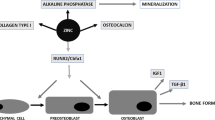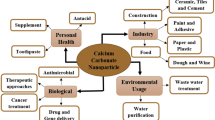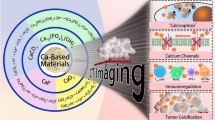Abstract
Bone mineralization is initiated by matrix vesicles, small extracellular vesicles secreted by osteoblasts, inducing the nucleation and subsequent growth of calcium phosphate crystals inside. Although calcium ions (Ca2+) are abundant throughout the tissue fluid close to the matrix vesicles, the influx of phosphate ions (PO43−) into matrix vesicles is a critical process mediated by several enzymes and transporters such as ecto-nucleotide pyrophosphatase/phosphodiesterase 1 (ENPP1), ankylosis (ANK), and tissue nonspecific alkaline phosphatase (TNSALP). The catalytic activity of ENPP1 in osteoblasts generates inorganic pyrophosphate (PPi) intracellularly and extracellularly, and ANK may allow the intracellular PPi to pass through the plasma membrane to the outside of the osteoblasts. Although the extracellular PPi binds to growing hydroxyapatite crystals to prevent crystal overgrowth, TNSALP on the osteoblasts and matrix vesicles hydrolyzes PPi into PO43− monomers: the prevention of crystal growth is blocked, and PO43− monomers are supplied to matrix vesicles. In addition, PHOSPHO1 is thought to function inside matrix vesicles to catalyze phosphocoline, a constituent of the plasma membrane, consequently increasing PO43− in the vesicles. Accumulation of Ca2+ and PO43− inside the matrix vesicles then initiates crystalline nucleation associated with the inner leaflet of the matrix vesicles. Calcium phosphate crystals elongate radially, penetrate the matrix vesicle’s membrane, and finally grow out of the vesicles to form calcifying nodules, globular assemblies of needle-shaped mineral crystals retaining some of those transporters and enzymes. The subsequent growth of calcifying nodules appears to be regulated by surrounding organic compounds, finally leading to collagen mineralization.

Modified from Hasegawa et al. (2011) with permission. Bars, a 50 μm, b–d 10 μm, e, f 5 μm




Modified from Kato et al. (2012)




Similar content being viewed by others
References
Ali SY, Sajdera SW, Anderson HC (1970) Isolation and characterization of calcifying matrix vesicles from epiphyseal cartilage. Proc Natl Acad Sci USA 67:1513–1520. https://doi.org/10.1073/pnas.67.3.1513
Amizuka N (2003) Bone matrix proteins and bone quality; Histological evaluation. J Jpn Soc Bone Morphom 13(1):5–9
Amizuka N, Ozawa H (1999) Calcium—basic, clinical, nutrition. In: Nishizawa Y, Siraki M, Ezawa I, Hirota T (eds) The national milk promotion association. Life Science Publishing Co. Ltd, Tokyo, pp 20–34
Amizuka N, Li M, Kobayashi M, Hara K, Akahane S, Takeuchi K, Freitas PH, Ozawa H, Maeda T, Akiyama Y (2008) Vitamin K2, a gamma-carboxylating factor of gla-proteins, normalizes the bone crystal nucleation impaired by Mg-insufficiency. Histol Histopathol 23(11):1353–1366. https://doi.org/10.14670/HH-23.1353
Amizuka N, Li M, Hara K, Kobayashi M, de Freitas PH, Ubaidus S, Oda K, Akiyama Y (2009) Warfarin administration disrupts the assembly of mineralized nodules in the osteoid. J Electron Microsc 58:55–65. https://doi.org/10.1093/jmicro/dfp008
Amizuka N, Hasegawa T, Oda K, Luiz de Freitas PH, Hoshi K, Li M, Ozawa H (2012) Histology of epiphyseal cartilage calcification and endochondral ossification. Front Biosci 4:2085–2100. https://doi.org/10.2741/526
Anderson HC (1969) Vesicles associated with calcification in the matrix of epiphyseal cartilage. J Cell Biol 41:59–72. https://doi.org/10.1083/jcb.41.1.59
Anderson HC, Sipe JB, Hessle L, Dhanyamraju R, Atti E, Camacho NP, Millan JL (2004) Impaired calcification around matrix vesicles of growth plate and bone in alkaline phosphatase-deficient mice. Am J Pathol 164(3):841–847. https://doi.org/10.1016/S0002-9440(10)63172-0
Azuma K, Shiba S, Hasegawa T, Ikeda K, Urano T, Horie-Inoue K, Ouchi Y, Amizuka N, Inoue S (2015) Osteoblast-specific γ-glutamyl carboxylase-deficient mice display enhanced bone formation with aberrant mineralization. J Bone Miner Res 30:1245–1254. https://doi.org/10.1002/jbmr.2463
Bianco P, Hayashi Y, Silvestrini G, Termine JD, Bonucci E (1985) Osteonectin and Gla-protein in calf bone: ultrastructural immunohistochemical localization using the Protein A-gold method. Calcif Tissue Int 37:684–686. https://doi.org/10.1007/BF02554931
Bonucci E (1967) Fine structure of early cartilage calcification. J Ultrastruct Res 20:33–50. https://doi.org/10.1016/S0022-5320(67)80034-0
Bonucci E (1970) Fine structure and histochemistry of “calcifying globules” in epiphyseal cartilage. Z Zellforsch Mikrosk Anat 103:192–217. https://doi.org/10.1007/BF00337312
Bonucci E (1971) The locus of initial calcification in cartilage and bone. Clin Orthop Relat Res 78:108–139. https://doi.org/10.1097/00003086-197107000-00010
Bonucci E, Gherardi G (1975) Histochemical and electron microscopy investigations on medullary bone. Cell Tissue Res 163:81–97. https://doi.org/10.1007/BF00218592
Boskey AL, Posner AS (1977) The role of synthetic and bone extracted Ca–phospholipid–PO4 complexes in hydroxyapatite formation. Calcif Tissue Res 23:251–258. https://doi.org/10.1007/BF02012794
Boskey AL, Maresca M, Ullrich W, Doty SB, Butler WT, Prince CW (1993) Osteopontin-hydroxyapatite interactions in vitro: Inhibition of hydroxyapatite formation and growth in a gelatin-gel. Bone Miner 22:147–159. https://doi.org/10.1016/S0169-6009(08)80225-5
Boyan BD, Schwartz Z, Swain LD, Khare A (1989) Role of lipids in calcification of cartilage. Anat Rec 224:211–219. https://doi.org/10.1002/ar.1092240210
Corsi A, Xu T, Chen XD, Boyde A, Liang J, Mankani M, Sommer B, Iozzo RV, Eichstetter I, Robey PG, Bianco P, Young MF (2002) Phenotypic effects of biglycan deficiency are linked to collagen fibril abnormalities, are synergized by decorin deficiency, and mimic Ehlers–Danlos-like changes in bone and other connective tissues. J Bone Miner Res 17:1180–1189. https://doi.org/10.1359/jbmr.2002.17.7.1180
de Bernard B, Bianco P, Bonucci E, Costantini M, Lunazzi GC, Martinuzzi P (1986) Biochemical and immunohistochemical evidence that in cartilage an alkaline phosphatase is a Ca2+-binding glycoprotein. J Cell Biol 103:1615–1623. https://doi.org/10.1083/jcb.103.4.1615
Gurley KA, Reimer RJ, Kingsley DM (2006) Biochemical and genetic analysis of ANK in arthritis and bone disease. Am J Hum Genet 79:1017–1029. https://doi.org/10.1086/509881
Hale JE, Fraser JD, Price PA (1988) The identification of matrix Gla protein in cartilage. J Biol Chem 263(12):5820–5824
Hall JG, Pauli RM, Wilson KM (1980) Maternal and fetal sequelae of anti-coagulation during pregnancy. Am J Med 68:122–140. https://doi.org/10.1016/0002-9343(80)90181-3
Hasegawa T, Li M, Hara K, Sasaki M, Tabata C, de Freitas PH, Hongo H, Suzuki R, Kobayashi M, Inoue K, Yamamoto T, Oohata N, Oda K, Akiyama Y, Amizuka N (2011) Morphological assessment of bone mineralization in tibial metaphyses of ascorbic acid-deficient ODS rats. Biomed Res 32:259–269. https://doi.org/10.2220/biomedres.32.259
Hasegawa T, Sasaki M, Yamada T, Ookido I, Yamamoto T, Hongo H, Yamamoto T, Oda K, Yokoyama K, Amizuka N (2013) Histochemical examination of vascular medial calcification of aorta in klotho-deficient mice. J Oral Biosci 55(1):10–15. https://doi.org/10.1016/j.job.2012.12.003
Hasegawa T, Yamamoto T, Tsuchiya E, Hongo H, Tsuboi K, Kudo A, Abe M, Yoshida T, Nagai T, Khadiza N, Yokoyama A, Oda K, Ozawa H, de Freitas PHL, Li M, Amizuka N (2017) Ultrastructural and biochemical aspects of matrix vesicle-mediated mineralization. J Dent Sci Rev 53:34–45. https://doi.org/10.1369/0022155416665577
Hauschka PV, Lian JB, Gallop PM (1975) Direct identification of the calcium-binding amino acid, gamma-carboxyglutamate, in mineralized tissue. Proc Natl Acad Sci USA 72(10):3925–3929. https://doi.org/10.1073/pnas.72.10.3925
Ho AM, Johnson MD, Kingsley DM (2000) Role of the mouse ank gene in control of tissue calcification and arthritis. Science 289:265–270. https://doi.org/10.1126/science.289.5477.265
Hoang QQ, Sicheri F, Howard AJ, Yang DS (2003) Bone recognition mechanism of porcine osteocalcin from crystal structure. Nature 425(6961):977–980. https://doi.org/10.1038/nature02079
Hoshi K, Amizuka N, Oda K, Ikehara Y, Ozawa H (1997) Immunolocalization of tissue non-specific alkaline phosphatase in mice. Histochem Cell Biol 107:183–191. https://doi.org/10.1007/s004180050103
Hoshi K, Ejiri S, Ozawa H (2001) Localizational alterations of calcium, phosphorus, and calcification-related organics such as proteoglycans and alkaline phosphatase during bone calcification. J Bone Miner Res 16:289–298. https://doi.org/10.1359/jbmr.2001.16.2.289
Houston B, Seawright E, Jefferies D, Hoogland E, Lester D, Whitehead C, Farquharson C (1999) Identification and cloning of a novel phosphatase expressed at high levels in differentiating growth plate chondrocytes. Biochim Biophys Acta 1448:500–506. https://doi.org/10.1016/S0167-4889(98)00153-0
Houston B, Stewart AJ, Farquharson C (2004) PHOSPHO1—a novel phosphatase specifically expressed at sites of mineralisation in bone and cartilage. Bone 34:629–637. https://doi.org/10.1016/j.bone.2003.12.023
Hunter GK, Hauschka PV, Poole AR, Rosenberg LC, Goldberg HA (1996) Nucleation and inhibition of hydroxyapatite formation by mineralized tissue proteins. Biochem J 317:59–64. https://doi.org/10.1042/bj3170059
Johnson K, Moffa A, Chen Y, Pritzker K, Goding J, Terkeltaub R (1999a) Matrix vesicle plasma membrane glycoprotein-1 regulates mineralization by murine osteoblastic MC3T3 cells. J Bone Miner Res 14:883–892. https://doi.org/10.1359/jbmr.1999.14.6.883
Johnson K, Vaingankar S, Chen Y, Moffa A, Goldring M, Sano K, Jin-Hua P, Sali A, Goding J, Terkeltaub R (1999b) Differential mechanisms of inorganic pyrophosphate production by plasma cell membrane glycoprotein-1 and B10 in chondrocytes. Arthritis Rheum 42:1986–1997. https://doi.org/10.1002/1529-0131(199909)42:9<1986::AID-ANR26>3.0.CO;2-O
Johnson K, Hashimoto S, Lotz M, Pritzker K, Goding J, Terkeltaub R (2001a) Up-regulated expression of the phosphodiesterase nucleotide pyrophosphatase family member PC-1 is a marker and pathogenic factor for knee meniscal cartilage matrix calcification.Arthritis Rheum 44: 1071–1081. https://doi.org/10.1002/1529-0131(200105)44:5<1071::AID-ANR187>3.0.CO;2-3
Johnson K, Pritzker K, Goding J, Terkeltaub R (2001b) The nucleoside triphosphate pyrophosphohydrolase isozyme PC-1 directly promotes cartilage calcification through chondrocyte apoptosis and increased calcium precipitation by mineralizing vesicles. J Rheumatol 28:2681–2691
Johnson K, Goding J, Van Etten D, Sali A, Hu SI, Farley D, Krug H, Hessle L, Millán JL, Terkeltaub R (2003) Linked deficiencies in extracellular inorganic pyrophosphate (PPi) and osteopontin expression mediate pathologic ossification in PC-1 null mice. J Bone Miner Res 18:994–1004. https://doi.org/10.1359/jbmr.2003.18.6.994
Kato K, Nishimasu H, Okudaira S, Mihara E, Ishitani R, Takagi J, Aoki J, Nureki O (2012) Crystal structure of Enpp1, an extracellular glycoprotein involved in bone mineralization and insulin signaling. Proc Natl Acad Sci USA 109:16876–16881. https://doi.org/10.1073/pnas.1208017109
Kim HJ, Minashima T, McCarthy EF, Winkles JA, Kirsch T (2010) Progressive ankylosis protein (ANK) in osteoblasts and osteoclasts controls bone formation and bone remodeling. J Bone Miner Res 25(8):1771–1783. https://doi.org/10.1002/jbmr.60
Kitaoka T, Tajima T, Nagasaki K, Kikuchi T, Yamamoto K, Michigami T, Okada S, Fujiwara I, Kokaji M, Mochizuki H, Ogata T, Tatebayashi K, Watanabe A, Yatsuga S, Kubota T, Ozono K (2017) Safety and efficacy of treatment with asfotase alfa in patients with hypophosphatasia: results from a Japanese clinical trial. Clin Endocrinol 87(1):10–19. https://doi.org/10.1111/cen.13343
Liu J, Nam HK, Campbell C, Gasque KC, Millán JL, Hatch NE (2014) Tissue-nonspecific alkaline phosphatase deficiency causes abnormal craniofacial bone development in the Alp(−/−) mouse model of infantile hypophosphatasia. Bone 67:81–94. https://doi.org/10.1016/j.bone.2014.06.040
Mackenzie NC, Zhu D, Milne EM, van ‘t Hof R, Martin A, Darryl Quarles L, Millán JL, Farquharson C, MacRae VE (2012) Altered bone development and an increase in FGF-23 expression in Enpp1(−/−) mice. PLoS One 7:e32177. https://doi.org/10.1371/journal.pone.0032177
Mark MP, Butler WT, Prince CW, Finkleman RD, Ruch J-V (1988) Developmental expression of 44-kDa phosphoprotein (osteopontin) and bone-carboxyglutamic acid (Gla)-containing protein (osteocalcin) in calcifying tissues of rat. Differentiation 37:123–136. https://doi.org/10.1111/j.1432-0436.1988.tb00804.x
Matsuzawa T, Anderson HC (1971) Phosphatases of epiphyseal cartilage studied by electron microscopic cytochemical methods. J Histochem Cytochem 19:801–808. https://doi.org/10.1177/19.12.801
Millan JL (2006) Alkaline phosphatases: structure, substrate specificity and functional relatedness to other members of a large superfamily of enzymes. Purinergic Signal 2:335–341. https://doi.org/10.1007/s11302-005-5435-6
Nakano Y, Beertsen W, van den Bos T, Kawamoto T, Oda K, Takano Y (2004) Site-specific localization of two distinct phosphatases along the osteoblast plasma membrane: tissue non-specific alkaline phosphatase and plasma membrane calcium ATPase. Bone 35:1077–1085. https://doi.org/10.1016/j.bone.2004.07.009
Narisawa S, Frohlander N, Millan JL (1997) Inactivation of two mouse alkaline phosphatase genes and establishment of a model of infantile hypophosphatasia. Dev Dyn 208(3):432–446. https://doi.org/10.1002/(SICI)1097-0177(199703)208:3<432::AID-AJA13>3.0.CO;2-1
Oda K, Amaya Y, Fukushi-Irie M, Kinameri Y, Ohsuye K, Kubota I, Fujimura S, Kobayashi J (1999) A general method for rapid purification of soluble versions of glycosylphosphatidylinositol-anchored proteins expressed in insect cells: an application for human tissue-nonspecific alkaline phosphatase. J Biochem 126:694–699
Okawa A, Nakamura I, Goto S, Moriya H, Nakamura Y, Ikegawa S (1998) Mutation in Npps in a mouse model of ossification of the posterior longitudinal ligament of the spine. Nat Genet 19:271–273. https://doi.org/10.1038/956
Ozawa H (1983) Current concepts of the morphophysiology of matrix vesicle calcification. Connect Tissue 15:1–12
Ozawa H (1985) Ultrastructural concepts on biological calcification; Focused on matrix vesicles. J Oral Biosci 27:751–774. https://doi.org/10.2330/joralbiosci1965.27.751
Ozawa H (1986) Ultrastructural aspects on the biological calcification with special reference to freeze-substitution at liquid helium temperature. Electron Microsc 57–60, Proc. XIth Int. Cong, Kyoto
Ozawa H, Yamada M, Yajima T (1978) The ultrastructural and cytochemical aspects of matrix vesicles and calcification processes. In: Talmage RV, Ozawa H (eds) Formation and calcification of hard tissues. Shakai Hoken Pub, Tokyo, pp 9–57
Ozawa H, Yamada M, Yamamoto T (1981) Ultrastructural observations on the location of lead and calcium in the mineralizing dentine of rat incisor. In: Ascenzi A, Bonucci E, de Bernard B (eds) Matrix Vesicles. Wiching Editore srl, Milano, pp 179–187
Ozawa H, Hoshi K, Amizuka N (2008) Current concepts of bone mineralization. J Oral Biosci 50:1–14. https://doi.org/10.2330/joralbiosci.50.1
Pauli RM, Lian JB, Mosher DF, Suttie JW (1987) Association of congenital deficiency of multiple vitamin K-dependent coagulation factors and the phenotype of the warfarin embryopathy: Cues to the mechanism of teratogenicity of coumarin derivatives. Am J Hum Genet 41:566–583
Price PA, Otsuka AA, Poser JW, Kristaponis J, Raman N (1976) Characterization of a gamma-carboxyglutamic acid-containing protein from bone. Proc Natl Acad Sci USA 73(5):1447–1451. https://doi.org/10.1073/pnas.73.5.1447
Ritter NM, Farach-Carson MC, Butler WT (1992) Evidence for the formation of a complex between osteopontin and osteocalcin. J Bone Miner Res 7:877–885. https://doi.org/10.1002/jbmr.5650070804
Roberts SJ, Stewart AJ, Sadler PJ, Farquharson C (2004) Human PHOSPHO1 exhibits high specific phosphoethanolamine and phosphocholine phosphatase activities. Biochem J 382(Pt 1):59–65. https://doi.org/10.1042/BJ20040511
Roberts S, Narisawa S, Harmey D, Millán JL, Farquharson C (2007) Functional involvement of PHOSPHO1 in matrix vesicle-mediated skeletal mineralization. J Bone Miner Res 22:617–627. https://doi.org/10.1359/jbmr.070108
Rutsch R, Vaingankar S, Johnson K, Goldfine I, Maddux B, Schauerte P, Kalhoff H, Sano K, Boisvert WA, Superti-Furga A, Terkeltaub R (2001) PC-1 Nucleoside triphosphate pyrophosphohydrolase deficiency in idiopathic infantile arterial calcification. Am J Pathol 158:543–554. https://doi.org/10.1016/S0002-9440(10)63996-X
Rutsch F, Ruf N, Vaingankar S, Toliat MR, Suk A, Höhne W, Schauer G, Lehmann M, Roscioli T, Schnabel D, Epplen JT, Knisely A, Superti-Furga A, McGill J, Filippone M, Sinaiko AR, Vallance H, Hinrichs B, Smith W, Ferre M, Terkeltaub R, Nürnberg P (2003) Mutations in ENPP1 are associated with ‘idiopathic’ infantile arterial calcification. Nat Genet 34:379–381. https://doi.org/10.1038/ng1221
Stewart AJ, Roberts SJ, Seawright E, Davey MG, Fleming RH, Farquharson C (2006) The presence of PHOSPHO1 in matrix vesicles and its developmental expression prior to skeletal mineralization. Bone 39(5):1000–1007. https://doi.org/10.1016/j.bone.2006.05.014
Takahashi T, Old LJ, Boyse EA (1970) Surface alloantigens of plasma cells. J Exp Med 131:1325–1341. https://doi.org/10.1084/jem.131.6.1325
Terkeltaub R, Rosenbach M, Fong F, Goding J (1994) Causal link between nucleotide pyrophosphohydrolase overactivity and increased intracellular inorganic pyrophosphate generation demonstrated by transfection of cultured fibroblasts and osteoblasts with plasma cell membrane glycoprotein-1. Arthritis Rheum 37:934–941. https://doi.org/10.1002/art.1780370624
Tesch W, Vandenbos T, Roschgr P, Fratzl-Zelman N, Klaushofer K, Beertsen W, Fratzl P (2003) Orientation of mineral crystallites and mineral density during skeletal development in mice deficient in tissue nonspecific alkaline phosphatase. J Bone Miner Res 18(1):117–125. https://doi.org/10.1359/jbmr.2003.18.1.117
Waymire KG, Mahuren JD, Jaje JM, Guilarte TR, Coburn SP, MacGregor GR (1995) Mice lacking tissue non-specific alkaline phosphatase die from seizures due to defective metabolism of vitamin B-6. Nat Genet 11(1):45–51. https://doi.org/10.1038/ng0995-45
Weiner S (1986) Organization of extracellularly mineralized tissues: a comparative study of biological crystal growth. CRC Crit Rev Biochem 20:365–408. https://doi.org/10.3109/10409238609081998
Whyte MP, Greenberg CR, Salman NJ, Bober MB, McAlister WH, Wenkert D, Van Sickle BJ, Simmons JH, Edgar TS, Bauer ML, Hamdan MA, Bishop N, Lutz RE, McGinn M, Craig S, Moore JN, Taylor JW, Cleveland RH, Cranley WR, Lim R, Thacher TD, Mayhew JE, Downs M, Millán JL, Skrinar AM, Crine P, Landy H (2012) Enzyme-replacement therapy in life-threatening hypophosphatasia. N Engl J Med 366(10):904–913. https://doi.org/10.1056/NEJMoa1106173
Wuthier RE (1975) Lipid composition of isolated epiphyseal cartilage cells, membranes and matrix vesicles. Biochim Biophys Acta 409:128–143. https://doi.org/10.1016/0005-2760(75)90087-9
Yadav MC, Simão AM, Narisawa S, Huesa C, McKee MD, Farquharson C, Millán JL (2011) Loss of skeletal mineralization by the simultaneous ablation of PHOSPHO1 and alkaline phosphatase function: a unified model of the mechanisms of initiation of skeletal calcification. J Bone Miner Res 26(2):286–297. https://doi.org/10.1002/jbmr.195
Yadav MC, Bottini M, Cory E, Bhattacharya K, Kuss P, Narisawa S, Sah RL, Beck L, Fadeel B, Farquharson C, Millán JL (2016) Skeletal mineralization deficits and impaired biogenesis and function of chondrocyte-derived matrix vesicles in Phospho1(−/−) and Phospho1/Pi t1 double-knockout mice. J Bone Miner Res 31(6):1275–1286. https://doi.org/10.1002/jbmr.2790
Yamada M (1976) Ultrastractural and cytochemical studies on the calcification of the tendon-bone joint. Arch Histol Jap 39:347–378. https://doi.org/10.1679/aohc1950.39.347
Acknowledgements
This study was partially supported by the Grants-in Aid for Scientific Research (Hasegawa T). The author expresses her gratitude to Prof. Norio Amizuka, Hokkaido University, for his critique of the manuscript.
Author information
Authors and Affiliations
Corresponding author
Ethics declarations
Conflict of interest
No potential conflicts of interest exist.
Rights and permissions
About this article
Cite this article
Hasegawa, T. Ultrastructure and biological function of matrix vesicles in bone mineralization. Histochem Cell Biol 149, 289–304 (2018). https://doi.org/10.1007/s00418-018-1646-0
Accepted:
Published:
Issue Date:
DOI: https://doi.org/10.1007/s00418-018-1646-0





